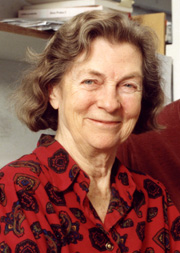Anne McLaren facts for kids
Quick facts for kids
Anne McLaren
|
|
|---|---|
 |
|
| Born | 26 April 1927 London, England
|
| Died | 7 July 2007 (aged 80) North Weald Bassett, England
|
| Alma mater | Oxford University |
| Spouse(s) | |
| Awards | Royal Medal (1990) Japan Prize (2002) |
| Scientific career | |
| Fields | Developmental biology, animal genetics |
| Doctoral advisor | Kingsley Sanders |
| Other academic advisors | J. B. S. Haldane Peter Medawar |
Dame Anne Laura Dorinthea McLaren (26 April 1927 – 7 July 2007) was a brilliant British scientist. She was a leader in the field of developmental biology, which is the study of how living things grow and develop. Her important work helped create in vitro fertilisation (IVF) for humans. IVF is a way to help people have babies. Anne McLaren received many awards for her amazing contributions to science.
Contents
Early Life and Learning
Anne McLaren was born in London, England, in 1927. Her father, Sir Henry McLaren, was a member of Parliament (an MP), which means he helped make laws for the country. Her family moved to North Wales when World War II started.
When she was a child, Anne even appeared in a movie called Things to Come! She studied zoology (the study of animals) at Lady Margaret Hall, Oxford, which is part of Oxford University. She continued her studies at University College London. There, she earned her DPhil degree in 1952. That same year, she married a fellow student named Dr. Donald Michie.
Early Career and Family
Anne McLaren and Donald Michie worked together at University College London. They studied how the number of bones in a mouse's back could change depending on its mother. Later, Anne McLaren began to research how mice become pregnant. This included studying superovulation, which means making an animal produce many eggs.
In 1958, she published a very important paper in the science magazine Nature. In this paper, she and John D. Biggers showed that they could take mouse embryos (very early babies) from a mother, grow them outside the body for a few days, and then put them back into another mother mouse. These mice then grew and were born successfully! This was a huge step forward for reproductive biology.
During this time, Anne McLaren also had three children:
- Susan Michie (born 1955)
- Jonathan Michie (born 1957)
- Caroline Michie (born 1959)
Anne and Donald divorced in 1959. Anne then moved to the Institute of Animal Genetics in Edinburgh to continue her research. She raised her children while also having a busy science career. This made her a strong supporter of government help for childcare.
Later Scientific Work
Anne McLaren spent 15 years at the Institute of Animal Genetics. She studied many things about how animals reproduce and develop. This included embryonic transfer in mice, which is moving an embryo from one animal to another.
In 1974, she became the Director of the MRC Mammalian Development Unit in London. This unit was part of the Medical Research Council, which supports health research. After retiring from that role in 1992, she moved to Cambridge. She joined the Wellcome/CRC Institute, which is now called the Gurdon Institute.
Anne McLaren also worked outside of her university labs. She was part of a special committee that looked into new technologies like IVF and how they should be used. This committee created the Warnock Report. She was also a member of the Nuffield Council on Bioethics, which discusses ethical questions in biology and medicine.
In 2004, Anne McLaren helped start the Frozen Ark project. This project aims to save the DNA and living cells of endangered animals around the world. It's like a special bank for animal genetic material, helping to protect species that are at risk.
Awards and Recognition
Anne McLaren received many important honours for her work.
- In 1975, she became a Fellow of the Royal Society. This is a very high honour for scientists in the UK.
- From 1991 to 1996, she was the Foreign Secretary of the Royal Society. She was the first woman to hold such a high position in the society's 330-year history!
- In 1986, she was made a Fellow of the Royal College of Obstetricians and Gynaecologists for her groundbreaking work on fertility.
- In 1993, she was given the title of DBE, which means she became a Dame.
- From 1993 to 1994, she was the president of the British Association for the Advancement of Science.
- In 2002, she won the Japan Prize for her work in developmental biology.
- In 2007, she received the March of Dimes Prize in Developmental Biology.
Death
Anne McLaren and her former husband, Donald Michie, both died in a car accident on 7 July 2007. She was 80 years old.
Legacy
Anne McLaren's scientific papers and notes are kept at the British Library. There is also a fund named after her to help encourage scientific study. In 2009, the Anne McLaren Laboratory for Regenerative Medicine was opened at the Cambridge Biomedical Campus.
On 26 April 2021, Google celebrated what would have been her 94th birthday with a special Google Doodle on its homepage.
See also
 In Spanish: Anne McLaren para niños
In Spanish: Anne McLaren para niños

